Arrive at the Hosea Kutako International Airport and depart for the Kalahari and Zebra Kalahari Lodge some 300 km south of the capital. Settle in and prepare for your afternoon game drive amongst the red linear dunes of the Kalahari of the 110 sq.km big Intu Afrika Game Reserve. The reserve is home to Zebra, Oryx, Wildebeest, Springbok (including the black Springbok), Waterbuck, Kudu, Blesbok, Tsessebe, Eland, Ostrich, Giraffe and even a lioness and there are many interesting bird species to discover whilst enjoying one of the two and a half hour game drives on offer. The guides are extremely knowledgeable and zealously share their passion for the animals, the plants and the area. The lone lioness whose partner succumbed to illness some time ago is a sight to behold in the Kalahari which is their natural habitat. She is enclosed in a 1000 hectare electrified camp.
At the end of the game drive watch the sun set from the top of a dune, while sipping your favourite cocktail, which in Africa is traditionally called Sundowner.



Afternoon
One of the most interesting and exciting activities on Intu Afrika is an hour long ‘Bushman Walk’ in the Kalahari landscape in the early morning hours. The term ‘Bushman’ now referred to as the San people, refers to the nomadic hunter-gatherers indigenous to this area. The San People know the Kalahari Desert better than any other human beings and have survived the dry conditions for generations. They have studied nature and know where to find food and water in the harsh conditions of the unrelenting and unforgiving desert landscapes. They are hunter-gatherers, hunting with bows and arrows, trapping small animals and eating edible roots and berries and they eagerly demonstrate this to guests. What makes this phenomenal experience special is the click language that the San use to express themselves and with dramatic illustrations, guests are able to communicate with and understand the interesting information the San people share.
After this exhilarating experience depart to drive through vast open plains interspersed with Inselbergs and along the edge of the southern Namib Desert to reach Desert Hills Lodge in the early afternoon. Enjoy the remainder of the day relaxing on the veranda of your bungalow.
The next morning visit Dune 45, which you have the opportunity to climb and enjoy the unfolding panorama around you. Take a leisurely walk to dead vlei to marvel at the age-old dead tree trunks on the white lake floor and surrounded by the worlds biggest sand dunes. On your way visit the Sesriem Canyon, a 36 metre-deep gorge cut into the limestone conglomerate. the afternoon is at leisure to relax at the pool from the morning activities.



Drive to the coast and Walvis Bay, traversing the desert from east to west. Spend the afternoon exploring the town and sip a cocktail for Sundowner watching the sunset over the Atlantic Ocean.
The next day spend a full day participating in a dolphin cruise in the morning and enjoying a 4x4 excursion to the freshwater lagoon of Sandwich Harbour in the afternoon. The return trip is a thrilling exercise in dune driving, where the off-road vehicles can show their best qualities as you cruise over and through the dune belt of the western Namib Desert.


Continue your journey to the Etosha National Park, where you will arrive in the early afternoon, to undertake your first game drive until sunset. After dinner sit down at the illuminated waterhole and watch as the nocturnal spectacle unfolds before you. The Okaukuejo waterhole is famous for the black rhino that frequent it at night to quench their thirst. Solitary elephants join in and assemble for their nightly silent rendezvous.

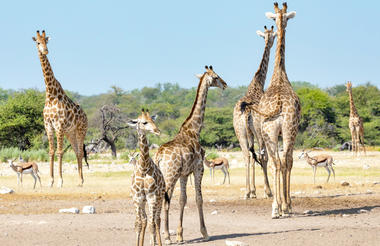
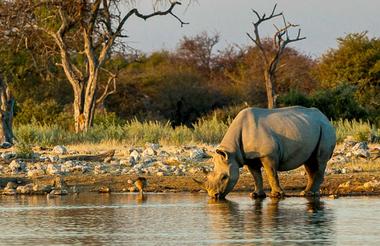


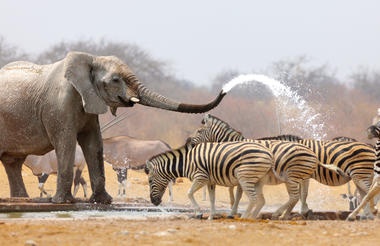
Transfer from Fiume Bush Camp to N'kwazi Lodge on the banks of the Kavango River. You have the possibility for a sunset river cruise with drinks on board the boat.
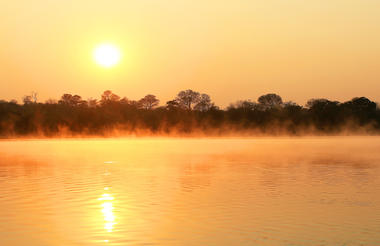
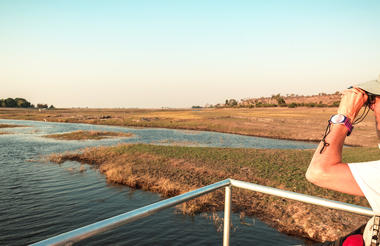
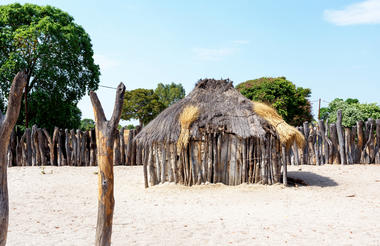
Sunset Cruise on Kavango River
Drive through the forests of the eastern Kavango Region to Divundu, where the Kavango River turns south from its eastern course, towards its mighty delta. Nunda River Lodge, where you will sleep for the night, lies on the banks of this river and near the Mahango Game Reserve. Here you have the opportunity for a leisurely afternoon game drive in your own vehicle or, if so wanted you can also participate in an optional guided game drive organised by the lodge.



Game Drive in Mahangu Game Reserve
Crossing the border into Botswana, travel to Nxamaseri Island Lodge 100 km further south, where you will stay the next two nights. In the afternoon of your first day there undertake a boat safari on the Okavango panhandle, which presents the beginning of the famous Okavango Delta .
The next day is dedicated to the "African Louvre". Visit the Tsodilo Hills, a sacred place for the San peoples, with its thousands of rock paintings Tsodilo Hills is a rare and unique place with an atmosphere of intrigue and mystery. The word Tsodilo is derived from the Hambukushu word 'sorile' which means sheer. It is believed to be the site of first Creation by the Bushmen who painted more than 3500 rock paintings against the magnificent stone faces of the hills.
The Tsodilo Hills have a special significance to the Bushmen who have been living here for thousands of years. The Tsodilo Hills consist of four large pieces of rock, rising unexpectedly from the dry expanse of desert. The Bushmen referred to the bigger rock as the 'male', the smaller one was known as the 'female', and the smallest one was the 'child'. According to legends the fourth hill was the male hill's first wife, whom he left for a younger woman, and who now prowls in the background.
The Tsodilo Hills are one of the most historically significant rock art sites in the world, It boasts 500 individual sites representing thousands of years of human habitation. Nobody knows the exact age of the paintings although some are thought to be more than 20 000 years old, whilst others are merely a century old.



Return to Namibia for your onward journey to Nkasa Lupala Tented Lodge in the eastern Caprivi. The lodge lies adjacent to the Nkasa Rupara National Park.
Nkasa Rupara forms a corridor for all large mammal species moving between Namibia and Botswana, particularly African elephant and buffalo. There are about 1 000 buffalo in Nkasa Rupara, the largest concentration in Namibia. Around 560 hippopotami and 500 crocodile occur in the park’s rivers and channels. Rare antelope species include sitatunga, puku, red lechwe, reed buck, and oribi.
Mammals of this park as well as reptiles feature elephants, lions, cheetahs, leopards, spotted hyenas, Cape wild dogs, roan antelopes, impala, kudu, warthog, baboons, spotted-necked otters, rock monitor lizards, and water monitor lizards.
About 450 bird species have been counted.[5] Several rare, vulnerable and endangered species are found here, such as wattled crane, Pel’s fishing-owl, black-cheeked lovebird and yellow-billed oxpecker. Other birds are Stanley's bustard, rosy-throated longclaw, Dickinson's kestrel, Allen’s gallinule, lesser jacana, black-winged and red-winged pratincole, long-toed lapwing, Luapula cisticola, coppery-tailed coucal, and black coucal.
Spent the afternoon for your arrival day with a boat cruiser on the Linyanti River.
The next day go on a morning game drive in the Mamili National Park to see many of the game including elephant, buffalo and with a bit of luck lion and leopard. In the afternoon follows another boat cruise on the Kwando River.



Chobe National Park is Botswana's first national park, and also the most biologically diverse. Located in the north of the country, it is Botswana's third largest park, after Central Kalahari Game Reserve and Gemsbok National Park, and has one of the greatest concentrations of game in all of Africa.The park is noted for having a population of lions which prey on African elephants, mostly calves or juveniles, but even subadults.
Continue your travel to Botswana and the Chobe National Park. check in at the Chobe Safari Lodge and prepare for your exciting afternoon game cruise on the Chobe River. See elephants crossing the river to feed on the many islands that lie in this water course, hippo lazing in the water and crocodiles sunbathing on the water's edge.
Watch the sun set over the river while sipping your favourite drink as the boat stops on the banks for this sundowner break.



Undertake an early morning game drive in the park before having breakfast. Then, nearing the end of your journey, today you visit the famous Victoria Falls in Zimbabwe.
While it is neither the highest nor the widest waterfall in the world, Victoria Falls is classified as the largest, based on its combined width of 1,708 metres (5,604 ft) and height of 108 metres 354 ft), resulting in the world's largest sheet of falling water. Victoria Falls is roughly twice the height of North America's Niagara Falls and well over twice the width of its Horseshoe Falls. In height and width Victoria Falls is rivalled only by Argentina and Brazil's Iguazu Falls.
Check in at the A'Zambezi River Lodge and in the early afternoon set off to explore the Zimbabwean side of the Falls. If there is a steady breeze you will experience many rainbows in the constant spray.

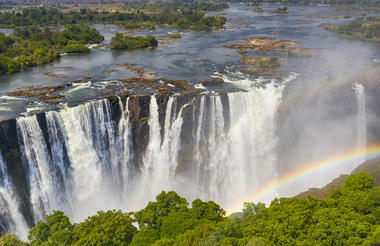
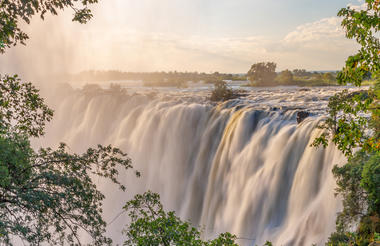
Visit of the Falls
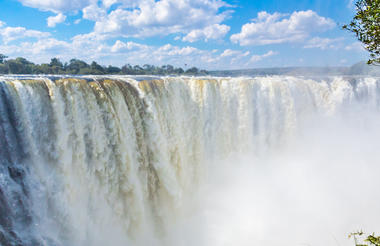
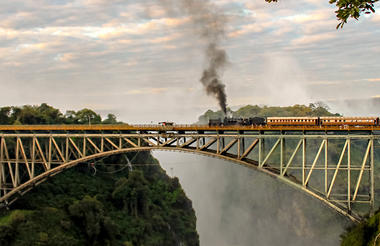
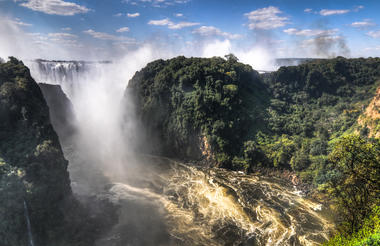
All good things have to come to an end and so today bid farewell to this natural wonder called Mosi-oa-Tunya and transfer to the airport for your return flight back home.



